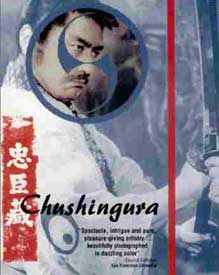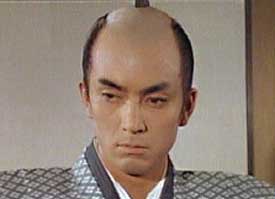 "On the 15th year of Genroku, 12th month, 15th day, we have come to do homage here, forty-seven men in all, from chamberlain Kuranosuke Oishi down to the footsoldier Kichiyemon Terasaka, all cheerfully eager to die on your behalf. We reverently announce this to the honoured spirit of our dead master." "On the 15th year of Genroku, 12th month, 15th day, we have come to do homage here, forty-seven men in all, from chamberlain Kuranosuke Oishi down to the footsoldier Kichiyemon Terasaka, all cheerfully eager to die on your behalf. We reverently announce this to the honoured spirit of our dead master."
Thus began Oishi's historical letter composed upon avenging Lord Asano of Ako, an event that has served almost as the national epic of the Japanese spirit, capturing as it does a capacity to suffer sadness & hardships without complaint, to adhere to the highest level of duty, devotion, altruism & bravery, & to make the ultimate sacrifice on principle.
Not every western viewer will be able to relate to the story of the Brave 47 Ronin in the manner it is usually told in cinematic presentations. Apart from the action-climax, it is the opposite of a samurai action story.
Of the dozens of films & television programs about the Brave 47, most tell pretty much the same story with only minor variants film to film. It generally progresses slowly like a funeral march & durge. It can test the patience of anyone who fails to respond emotionally to the quieter aspects of the story, which are the predominant components of this heavily romanticized piece of history.
But even those unfamiliar with the spiritual dimensions of this amazing event of the Edo period, allowing oneself to be immersed in the pokily developing adventure will result, by that final raid, in a deeply moving experience, having the noblest of contexts for the most terrible of actions.
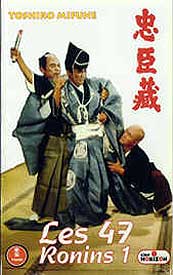 Hiroshi Inagaki's two-part, four hour epic of Chushingura begins with Chushingura: Hana no maki (The Loyal 47 Ronin Part I: Blossoms, Toho, 1962). Hiroshi Inagaki's two-part, four hour epic of Chushingura begins with Chushingura: Hana no maki (The Loyal 47 Ronin Part I: Blossoms, Toho, 1962).
The first hour focuses on the difficulties Lord Asano (Yuzo Kayama) had coping with the greedy Kozukenosuke Kira (Chusha Ichikawa). Asano is a country daimyo whose secret salt recipe has helped make his clan wealthy. Kira had formerly provided a large bribe to Asano to reveal the secret salt recipe, but Asano returned the bribe with apologies.
The day comes when Asano needs something from Kira. Asano has been chosen to head an elaborate reception for the nobility from Kyoto visiting the shogun at Edo Castle. The specifics of ritualistic behavior around royalty are not things swiftly learned by a rural daimyo. Kira as a well trained master of ceremonies is to instruct Asano in the specifics & niceties of each stylized ritual.
Kira lives by a dispicable code, telling even his own disapproving wife, "With lust & greed as my values, I intend to live a long life." He expects then demands to be bribed for every favor large or small, but Asano believes bribery is the root of all corruption in government. When he gives gifts they are useful & pleasant things, but of no untoward value.
A battle of wills is ongoing with Kira keeping Asano fretful that he will even be able to pull off his ceremonial duties. Asano continues to disregard Kira's overt "hints" that whoever gives the best gifts has the easiest outcome. Eventually Kira slaps Asano with his fan, & the young daimyo, already pushed to the edge, draws his sword & wounds Kira while within Edo Castle, a breach of propriety he well knows will have ferocious repurcussions.
Kira is sent home to recover from his wounds & never punished, whereas Asano is instructed to commit seppuku. Asano, admitting to his failure, does have regrets, though he is unapologetic about attacking the insufferable Kira. He regrets his clan will be abolished which means his vassals will be homeless. If only he had succeeded in killing Kira, he would not be bitter.
The first hour of part I climaxes with Asano clad in white about to commit seppuku & have his head struck off, but a film this exceedingly tasteful will cut away before blood is shown.
The story is too familiar to be suspenseful & the drama stems much more from the honest & proud Asano's state of mind throughout his torments under the thumb of greedy & corrupt Kira, until Asano's temper is finally pushed him beyond the limit.
Not all filmed versions show quite so much of the relationship between Asano & Akira, & Inagaki spends more time than most in making sure everyone fully understands why the harshest possible vengeance against lecherous old fart would be satifying at any cost.
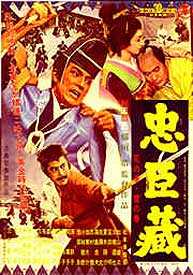 Another hour of Part I is spent showing the response of Asano's vassals at Ako castle. Sanpei Kanno (Mannosuke Nakamura) is sent by relay palanquin to Ako, a journey that requires him to sit up in the palanquin for three days & nights to bring the unfortunate news. Another hour of Part I is spent showing the response of Asano's vassals at Ako castle. Sanpei Kanno (Mannosuke Nakamura) is sent by relay palanquin to Ako, a journey that requires him to sit up in the palanquin for three days & nights to bring the unfortunate news.
His palanquin barers at one point scatter a group of pilgrims & cause an old woman to fall from the road. Sanpei feels horrible about it, & shouts his apologies, but the crisis requires him to be borne full tilt toward Ako.
Chamberlain Oishi (Koshiro Matsumot) is the central figure for the rest of Part I. Giving up the castle to the shogunate & scattering the most faithful of Asano's vassals to the wind, they will eventually gather to effect their ultimate vengeance.
But Oishi will first strive to have Asano's brother instated as clan leader, thereby preserving the clan. That is an effort bound to fail. Until failure is certain, Oishi spends the year living a dissolute life intended to fool the government & Kira's watchful spies that Asano's men will not pursue vengeance.
Every version of Chushingura selects its own choice miscellaneous ronin to tell their stories in encapsulated forms. Obvously forty-seven different stories cannot be told in even a four-hour epic. And there are in reality closer to sixty stories that might be told, as the brave 47 who made the final raid leaves out several people, some of whom failed to arrive through reasons beyond their control. Often the only distinguishing factor from version to version is which of these many lives are highlighted.
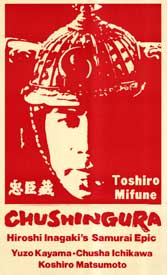 Inagaki elects to tell Sanpei's story, the courier who first arrived at Ako by relay palanquin. The old woman knocked from the highway dies of her injury, & her family pursues Sanpei for revenge. Inagaki elects to tell Sanpei's story, the courier who first arrived at Ako by relay palanquin. The old woman knocked from the highway dies of her injury, & her family pursues Sanpei for revenge.
As a virile young samurai he could easily kill any of these vengeance-seeking peasants. But given the secret plan of the 47 ronin, he well understands the righteousness of their quest for revenge, & injustice it would be if he were to wipe out a family instead of himself dying honorably for his irreversible error.
Sanpei invites the avengers to his courtyard on a certain night & they arrive eagerly, though knowing the combined effort of the armed men & women of the grieving family might fail to achieve more than their own sacrifice. But upon their arrival, Sanpei commits throat-piercing jigai in front of them.
His only regret was that he would not be able to join the revenge raid against Kira. He had visited Oishi earlier that day in apology. Otherwise, as a proud samurai, he is not regretful to die for the sake of another family's vengeance against him.
When Oishi learns of Sanpei's death, he dares not grieve openly, as he is being watched for signs of his intent to pursue revenge against Kira. He must continue his pretence of being a morally fallen wastral who cares only about brothels & song & sake.
He announces to fellow party-goers that his most precious pet sparrow has died & they must have a wake. A satiric pretense of drunken grief is taken up by the revellers, & Oishi sprinkles water on the faces of prostitutes & entertainers & himself, an extravagant method of hiding his actual tears.
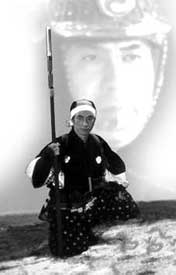 Thus two hours of samurai drama have passed with scarsely any action, & it's only half over. Chushingura: Yuki no maki (The Loyal 47 Ronin Part II: Snow, Toho, 1962) continues the story of Oishi's misleading behavior. Thus two hours of samurai drama have passed with scarsely any action, & it's only half over. Chushingura: Yuki no maki (The Loyal 47 Ronin Part II: Snow, Toho, 1962) continues the story of Oishi's misleading behavior.
All Edo has expected the masterless samurai to avenge their lord. Not only the government & Kira's allied clan, but also the public must be misled. Several of the impatient ronin awaiting instruction from Oichi suffer greatly & may, along with the public, begin to doubt the chamberlain's intent.
The cast does not include many faces that are internationally known, & even in Japan it was advertised as though Toshiro Mifune were the star. He's not. He has a powerful small role a bit larger than mere cameo. In Part I he showed up momentarily as a drinking partner of one of the ronin, Yasubei Horibe (Tatsuya Mihashi). He is Genba Tawaraboshi, a great spearman as well as a great drinker.
In Part II we glimpse him attempting to hire himself out as a bodyguard to anyone willing to pay his extravagant price. Pride will not permit him to work as a yojimbo for the amount that would be paid any random swordsman.
When Oishi hears of it, the worry is that cowardly Kira will eventually be willing to pay the price, & a spearman as powerful as Genba could skew the odds in favor of Kira.
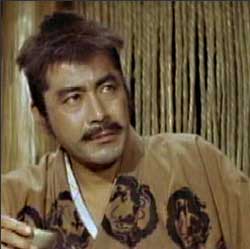 I have to interrupt this overview of the film's narration to narrate a story of my own. Many years ago I had a great friend, H. Warner Munn, or Harold, an author who had been publishing novels & tales since the start of the pulp era in the 1920s. I have to interrupt this overview of the film's narration to narrate a story of my own. Many years ago I had a great friend, H. Warner Munn, or Harold, an author who had been publishing novels & tales since the start of the pulp era in the 1920s.
I loved that guy & would visit him almost weekly in the next city down the coast. I'd listen to him read old stories or new ones in progress in his mellow, artful reading voice. His were tales of heroism or horror, just the things I love.
We also saw lots of films together. I'd seen several different films about the Brave 47 Ronin, but he'd never had the opportunity to see even one. Nevertheless, he knew all about them, from books. He was deeply moved by the faithful gorey bravery of Asano's men, such that tears sprang to his eyes when he spoke of them.
There was no Japanese cinema in Tacoma, but in my city there were two. I assured Harold one of the Seattle cinemas would be showing one or another film version of this great story, & I'd let him know when it happened.
Months later Hiroshi Inagaki's version played not in one of the ethnic theaters, but at a regular repertory revival cinema in my immediate bohemian neighborhood of Capital Hill. I called Harold & told him Chushingura was playing for two nights only at the Harvard Exit.
He drove down from Tacoma & we went to see it. He was particularly eager to see who he called "my boy," Toshiro Mifune, his favorite actor in the whole world.
He'd be a little disappointed at how small Mifune's role was in such a long film, but when the character of Gemba did finally take his stand in at the bridge to keep anyone from reaching Kira's mansion who might interfer with the revenge, Harold threw his arms in the air & his voice arose in the darkness of the theater crying out, "That's my boy!"
Harold was limping badly & did not look well, & such an exceedingly long movie took a lot of him. But his joy was palpable. He never told me or any of his filmic & literary friends he was dying of cancer. A very short time after he would be dead & my last experience with him would be watching Chushingura.
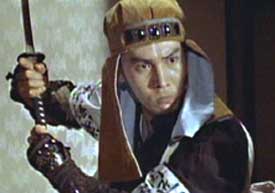 Chamberlain Oichi's decision was not easily made. He said, "I had hoped to live out my life uneventfully, a useless soldier in peace time." When vassals gather at Ako Castle for Oichi's decision, discussions assert that everyone present is willing & ready to die, but that it should not be done while Kira lives. Chamberlain Oichi's decision was not easily made. He said, "I had hoped to live out my life uneventfully, a useless soldier in peace time." When vassals gather at Ako Castle for Oichi's decision, discussions assert that everyone present is willing & ready to die, but that it should not be done while Kira lives.
The bulk of Part II regards the manner by which the brave ronin put the government off guard & awaited the right moment for their revenge raid. Kira, an old man, is not inherently a worthy opponent. He will indeed die a coward. The heroism is not in beheading a cringing old man, but in loyally pursuing justice even if one must afterward die for one's bravery.
Kira hides in the mansion as the brave 47 reeve through the household killing anyone who faces them with arms, in a protracted battle with extraorindary choreography. Anyone who just wanted samurai action & had been disappointed by three & a half hours of "mere" drama will not after all be disappointed. There are worthy fighters on both sides of the event, encounters that balance great beauty with the horror of violent death.
Asano's wife has an intensely emotional scene immediately after it is reported to her that vengeance has been done. She is sorry to have berated Oichi at their last meeting while he pretended he was going to give up his mission & go live as a farmer, for there was a spy in Lady Asano's household & they were denied the final farewells they both wanted.
When the Brave 47 commit seppuku it is because their act was illegal, not because it was immoral, & they were knowingly prepared for this outcome from the start. The sound of a warbler is evocative of a happy occasion. I believe even many a western viewer will feel the almost religious fascination for these comrades by this time in the tale. The sentimental treatment of death faced willingly by heros clad in white is heartbreaking in its tragic grace.
Chikara the youngest of the brave 47 goes first to his death, & Kuramosuke Oishi is last to go with quiet dignity & a last humbling speech: "The oldest at seventy-eight & the youngeste at fifteen, each & every one was truly a great comrade."
The disembowelments & beheadings of the Brave 47, as with Lord Asano, occurred off-screen, except for Oishi who we observe to the last.
copyright © by Paghat the Ratgirl
|
